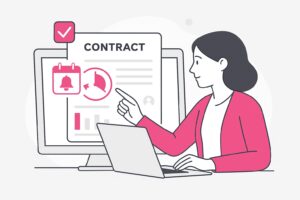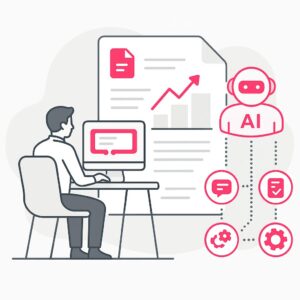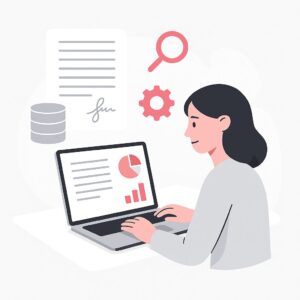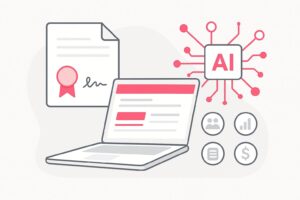What is Contract Analytics Software?
Contract analytics software is a technology solution that uses artificial intelligence and machine learning to automatically extract, analyze, and report on data within contracts. Concord’s analytics software transforms unstructured contract text into structured, actionable insights that help organizations manage risk, improve compliance, and optimize contract performance.
Contract Term Extractor
Paste your contract text below to extract key terms and information
Analyzing contract…
Extracted Terms
Turn contracts from static files to strategic assets
Real-world impact: Case studies in contract analytics software
Case Study: Custom Properties Unlock Strategic Contract Data at LeoVegas

Key Benefits:
- • Custom property tagging
- • Instant filtering & reporting
- • Proactive renewal management
LeoVegas struggled to extract key data from complex contracts with multiple addenda and revisions. Legal spent 10 hours weekly searching for information, delaying critical decisions.
How Concord helped:
- • Concord’s custom properties tag contracts by jurisdiction, terms, and clauses
- • Filter and sort hundreds of contracts instantly
- • Generate reports in minutes, not weeks
“The custom properties functionality, that’s where Concord really helps us save time. Projects that used to take two weeks to do manually can now be done in a single afternoon.” — Michael Cuschieri, Head of Legal
Case Study: AI-Powered Contracts Accelerate Sales at PAAY

Key Benefits:
- • Automated PDF data extraction
- • HubSpot integration
- • Built-in redlining
PAAY’s manual contracting processes created sales bottlenecks. Their legacy system couldn’t scale with growth, delaying deal closures.
How Concord helped:
- • Concord’s AI extracts data from any document format
- • Direct HubSpot sync eliminates manual entry
- • Mobile redlining enables deals anywhere
“There’s no other contract platform that delivers this much value at this price point. Concord has just been great for us.” — Jamie Garfield, VP of Sales

From legal document to strategic assets, through contract analytics
Contract ownership is evolving beyond the legal department. Concord’s 2024 survey of finance and operations leaders revealed that 100% of respondents noted that contract management is becoming a cross-functional imperative. CFOs, finance heads, operations managers, and procurement specialists are all taking greater ownership of the contract process.
As Nikos Anthopoulos, Efficiency Manager at Navarino, explains: “I’m under the office of the CEO. My role is to help processes and software run faster.” This statement captures the strategic importance that organizations now place on contract efficiency.
See Concord’s contract analytics software in action.

Automated data extraction and analysis
Advanced contract analytics software leverages natural language processing (NLP) and machine learning to automatically extract key information from agreements, including:
- Parties and signatories
- Key dates (effective dates, expiration dates, renewal deadlines)
- Financial terms and obligations
- Service level agreements (SLAs)
- Legal provisions and clauses
- Risk factors and compliance requirements
- Hidden costs
Michael Bearman, Chief Legal & Safety Officer at Vecna Robotics, highlights the transformative impact of this automation: “I used to have to spend lots of time on this, but now I just hit ‘create document’ because the AI does a great job automatically. Before we’d make errors like missing key dates or transposing numbers, which caused problems down the line. Now, with Concord, that information is automatically captured and validated, so we can trust its accuracy.”
Centralized contract repository with advanced search capabilities
The lack of real-time visibility into contract data is a major pain point for organizations. In Concord’s 2024 survey, 100% of finance and operations leaders highlighted this issue as a significant challenge.
As Gaia Olcese, Procurement Manager at Satispay, notes: “Better visibility would be amazing. We have more than 12,000 contracts, and their data is not sorted.” This inability to quickly find and analyze contract data hinders proactive management, creates inefficiencies, and exposes organizations to unnecessary financial risk.
Modern contract analytics platforms address this through:
- Centralized storage for all agreements
- Advanced search functionality that locates specific clauses and provisions
- Customizable tags and metadata for efficient organization
- Optical character recognition (OCR) to make even scanned documents searchable
- Automated categorization of contracts by type, department, or risk level


Proactive renewal management
Effective renewal management represents a significant opportunity for cost savings. Research indicates that 88% of organizations struggle with managing contract renewals effectively, often missing opportunities to renegotiate terms or accidentally allowing unfavorable agreements to auto-renew.
David Morgan, CFO at Loop Returns, articulates this challenge succinctly: “We’ve passed an auto renewal cut off date, and now we’re locked in.” This highlights the financial repercussions of delayed decision-making.
Advanced contract analytics platforms address this through:
- Automated alerts for upcoming renewal dates
- Renewal workflows that assign tasks to responsible stakeholders
- Historical spending analysis to inform renewal negotiations
- Vendor performance tracking to support data-driven renewal decisions
The role of AI in modern contract analytics

Current AI capabilities and limitations
Artificial intelligence is dramatically reshaping contract repository software, offering unprecedented efficiency and insights. A comprehensive market analysis found that 88% of finance and operations leaders recognize AI’s transformative potential, while acknowledging the need for careful implementation and human oversight.
AI’s current capabilities in contract analysis include:
- Automated data extraction: Identifying and classifying key contract elements
- Clause recognition: Spotting standard and non-standard clauses
- Risk identification: Flagging potentially problematic language or terms
- Pattern recognition: Identifying trends across contract portfolios
- Anomaly detection: Highlighting unusual provisions that deviate from standards
However, AI in contract analytics also has important limitations:
| Capability | Current State | Limitations |
|---|---|---|
| Data extraction | Highly effective for structured data and standard clauses | May miss nuanced or unusual provisions |
| Risk assessment | Can identify common risk factors and flag for review | Cannot fully assess contextual or business risks |
| Compliance monitoring | Effective for explicit regulatory requirements | Limited understanding of complex regulatory landscapes |
| Contract drafting | Can generate standard clauses and templates | Limited creativity for complex negotiations |
| Negotiation guidance | Can provide historical data on negotiation outcomes | Cannot fully replace human judgment and relationship management |
As Pepe Carr, General Counsel at Sand Technologies, observes: “If your learning model can raise their hand and say, ‘I don’t know what this is, please take a look,’ then you are off to reduce legal headcount.” This highlights the value of “human-in-the-loop” systems, where AI assists legal professionals by flagging potential issues for review rather than making final decisions autonomously.
Tammy Carroll, Contract and Strategy Manager at OneCare Vermont, reinforces this perspective: “You still need a human.” This reflects the understanding that AI should be seen as a tool to augment, not replace, human judgment.
Future directions in AI-powered contract analytics
As natural language processing and machine learning continue to advance, we can expect to see AI contract analytics expand in several directions:
- Predictive analytics: Using historical data to forecast potential contract outcomes and suggest improvements
- Conversational interfaces: Allowing users to query contract data using natural language
- Automated benchmarking: Comparing contract terms against industry standards and suggesting optimizations
- Integration with negotiation processes: Real-time guidance during contract negotiations
- Contextual understanding: Better comprehension of industry-specific terminology and requirements

Integration: The key to creating a “single source of truth”
The challenge of data silos
The concept of a “single source of truth” for contract data is a powerful ideal. However, Concord’s survey revealed that 75% of finance and operations leaders acknowledge that achieving this ideal is more complex than it seems. Data silos, where contract information is scattered across ERPs, CRMs, specialized tools, and even email inboxes, are the primary obstacle.
David Morgan, CFO at Loop Returns, describes how his billing team often has to “crack open the PDF” because not all contract information syncs with their billing system. This reliance on unstructured data highlights the inefficiency and potential for errors inherent in manual reconciliation.
The integration imperative
Modern legal contract management software platforms address this challenge through robust integration capabilities. Research indicates that 75% of organizations consider seamless integrations between contract lifecycle management systems and other core business applications to be essential.
Christopher Tufts, FP&A Manager at Iterable, emphasizes this point: “An integrated CLM is important so we can serve all our principal audiences from the same system.”
Effective integrations should include:
- Two-way data synchronization: Ensuring data consistency across systems
- Automated triggers: Initiating actions in other systems based on contract events
- Native integrations: Pre-built connections to common business applications
- APIs and webhooks: Enabling custom integrations for specialized needs
Implementation best practices: A phased approach
Successfully implementing contract analytics requires a strategic, phased approach that balances quick wins with long-term transformation. Based on insights from finance and operations leaders across various industries, here is a recommended implementation roadmap:
Phase 1: Quick wins (within 3 months)
- Conduct a contract inventory audit: Identify where contracts are stored, what data is captured, and where inconsistencies exist
- Implement standardized naming conventions and tagging: Improve searchability and lay the groundwork for future automation
- Start tracking key contract metrics: Measure active contracts, total contract value, and average cycle time to establish a baseline
Phase 2: Short-term priorities (within 6-12 months)
- Evaluate and select a CLM solution: Prioritize data accuracy, robust reporting capabilities, and integration potential
- Implement automated alerts for key contract dates: Begin proactive management of renewals and deadlines
- Explore AI-powered solutions: Start automating data entry and basic contract analysis
- Establish clear guidelines for AI usage: Maintain human review and validation of AI-generated insights
Phase 3: Long-term investments (12+ months)
- Foster a culture of contract awareness: Establish clear roles and responsibilities across departments
- Explore advanced analytics capabilities: Implement risk scoring, anomaly detection, and predictive analytics
- Track and communicate ROI: Measure contract cycle time reduction, cost savings, and compliance improvements
- Continuously refine and optimize: Evolve processes based on data and user feedback
Choosing the right contract analytics solution

Key evaluation criteria
When evaluating contract analytics solutions, organizations should consider:
- Data extraction accuracy: The system’s ability to correctly identify and extract key information
- Integration capabilities: Native connections to existing business systems
- User experience: Intuitive interfaces for legal and non-legal users
- AI capabilities: Current functionality and development roadmap
- Security and compliance: Data protection measures and regulatory adherence
- Customization options: Ability to adapt to specific business needs
- Implementation support: Training, onboarding, and ongoing assistance
- Total cost of ownership: Subscription fees, implementation costs, and ROI potential
The Concord advantage
Concord’s Agreement Intelligence platform stands out as the best contract lifecycle management software, through its:
- AI-powered data extraction that automatically identifies key terms, dates, and obligations
- Intuitive interface that requires minimal training for both legal and non-legal users
- Robust integration capabilities with popular CRM, ERP, and financial systems
- Comprehensive workflow tools that streamline contract processes
- Advanced analytics that provide actionable insights into contract portfolios
As Jamie Garfield, VP of Sales at PAAY, observes: “Concord has just been great for us. We adore the AI features. There’s no other contract platform that delivers this much value at this price point. Period.”

Contract Analytics Solution Comparison (May 2025)
| Feature | Concord | DocuSign CLM | Ironclad |
|---|---|---|---|
| Starting Price | $399/month | Custom pricing (estimated $1,000+/month) | $30,000-$120,000/year |
| Implementation Time | Less than 1 day | 2-3 months | 2-4 weeks |
| AI-Powered Analytics | Comprehensive (data extraction, risk analysis, forecasting) | Advanced (focused on extraction and review) | Moderate (primarily for contract creation) |
| Integrations | Native CRM + 5,000+ via Zapier | Salesforce, SAP, NetSuite | Limited integrations |
| User Experience | Intuitive (4.7/5 user rating) | Complex (4.4/5 user rating) | Steep learning curve (4.7/5 user rating) |
| E-Signatures | Unlimited included | Additional cost | Included in premium plans |
| Market Share (2025) | 14.23% | 6.69% | Not publicly disclosed |
Source: Independent market analysis based on vendor data as of May 2025
Frequently Asked Questions
What data can contract analytics software extract from agreements?
Contract analytics software automatically extracts key information including parties and signatories, effective dates and renewal deadlines, financial terms and obligations, service level agreements (SLAs), legal provisions and clauses, and risk factors. This automated extraction eliminates manual data entry and reduces errors.
How does contract analytics software improve renewal management?
Contract analytics software provides automated alerts for upcoming renewal dates, creates renewal workflows that assign tasks to stakeholders, analyzes historical spending to inform negotiations, and tracks vendor performance. This prevents missed auto-renewals and enables strategic renegotiation opportunities.
Can contract analytics software integrate with existing business systems?
Yes, modern contract analytics software offers robust integration capabilities including two-way data synchronization with CRMs and ERPs, automated triggers based on contract events, native integrations with popular business applications, and APIs for custom integrations. This creates a single source of truth for contract data.
What security features should contract analytics software include?
Contract analytics software should provide enterprise-grade security including SOC 2 Type II certification, GDPR compliance, comprehensive audit trails, custom permission settings, and zero data retention policies for AI training. These features ensure contract data remains protected and compliant.
How much time can contract analytics software save organizations?
Contract analytics software typically reduces contract administration costs by 25-30% and contract cycle times by 50-70%. Organizations report saving thousands of labor hours through automated data extraction, streamlined workflows, and improved visibility into contract portfolios.
What makes AI-powered contract analytics software different from basic contract management?
AI-powered contract analytics software uses natural language processing to understand contractual language, machine learning to identify patterns and risks, and automated anomaly detection. Unlike basic storage systems, it transforms unstructured contract data into actionable business insights for strategic decision-making.
Can small businesses benefit from contract analytics software?
Yes, contract analytics software benefits organizations of all sizes. Small and mid-sized businesses often see proportionally greater benefits due to limited legal and administrative resources. The software provides enterprise-level visibility and control without requiring additional headcount.
What implementation approach works best for contract analytics software?
Successful contract analytics software implementation follows a phased approach: Phase 1 (0-3 months) focuses on contract inventory and standardization, Phase 2 (6-12 months) implements automated alerts and AI features, and Phase 3 (12+ months) establishes advanced analytics and culture change. This ensures quick wins while building long-term transformation.
